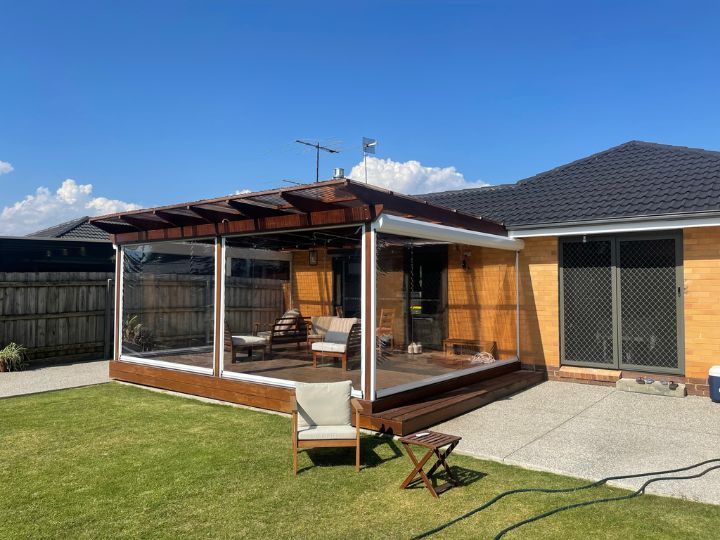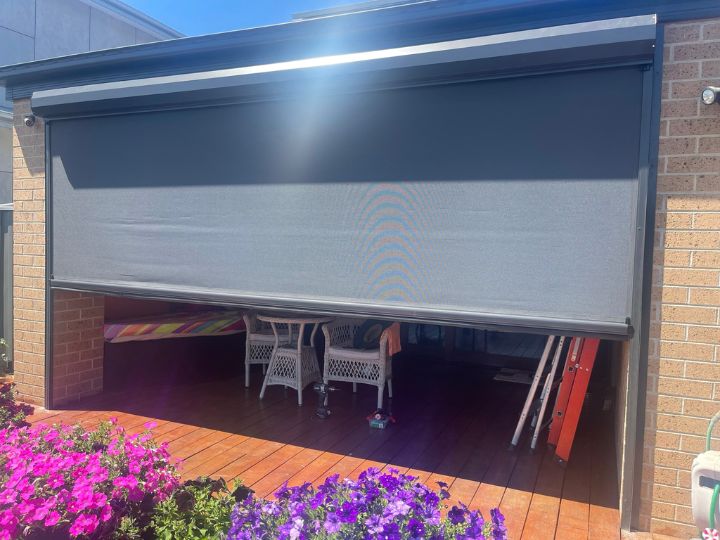Pergolas provide shade and serve as a framework for climbing plants in an outdoor setting. They usually consist of vertical pillars supporting an open lattice or cross-beam ceiling. The materials used to build pergolas are important since they affect their overall appearance, longevity, and maintenance needs. The most commonly used materials are wood, metal and fibreglass.
To get the best suggestion on what material you should use for your application, you should contact an expert. At Brighter Blinds And Doors, we have a variety of materials that you can choose from. Here are some of the typical materials used to build pergolas.
Wood
Wood is still a popular material for pergola blinds because of its inherent beauty and adaptability. It not only gives a rustic and classy look but also increases the aesthetic value of the pergola. The most common kinds of woods are listed below:
Cedar
This wood is a popular option for outdoor projects because of its natural resistance to external factors like moisture and fungus. It performs well against insects and has great endurance. With time, its rich color will fade beautifully.
Redwood
Like cedar, redwood is valued for its inherent ability to endure external factors and prevent the growth of insects. It has a pronounced reddish color and can be stained to give it a more polished appearance or left untreated for a rustic appearance.
Pressure-Treated Pine
Pine is widely accessible and reasonably priced. It is more pest resistent after pressure treatment, which qualifies it for outdoor use. To fit various styles, it can be painted or stained. Tropical hardwoods, such as teak and ipe, are incredibly resilient and have a built-in defence against insects and decay.
To maintain their appearance, they need to be maintained regularly and are typically more expensive. Wooden pergolas can be tailored with different finishes and patterns to match various architectural types and provide a cozy, welcoming atmosphere.
Metal
Modern and sleek metal pergolas are a stylish substitute for conventional wood ones. They are inexpensive and do not require high maintenance. Their endurance against external factors and high longevity are also appreciated. Pergolas made of metal are strong, lightweight, and resistant to corrosion. They may be powder-coated in a variety of colors to complement outdoor décor. Frequently utilized metals used for building pergolas are given below;
Steel
Fabric canopies and polycarbonate panels are too heavy for steel pergolas to support. They can have complex designs and are frequently powder-coated to stop rust. However, steel is a solid metal with higher durability and stability.
Iron
Well-known for its durability and traditional design, iron pergolas give outdoor areas a timeless charm. They are incredibly durable but need constant maintenance to avoid rust. Because of their durability and resistance to weather, iron pergolas are expensive. They are perfect for contemporary and industrial outdoor environments.
Vinyl
Vinyl pergolas are becoming more and more common because of how versatile and low-maintenance they are. It is a long-lasting material for outdoor projects since it is resistant to corrosion, degradation, and pests. Painting or staining vinyl is not necessary, unlike wood. To keep it looking new, a simple periodic washing with soap and water is generally enough.
Vinyl pergolas allow for endless design options because they are available in a range of colors and styles, including textures that mimic real wood. They are popular because of their easy maintenance and sleek design, which makes them ideal for contemporary gardens and residential buildings.
Fibre Glass
Pergolas made of fibreglass combine strength and lightweight. Fibreglass is resistant to adverse weather without warping, splitting, or fading, making it stronger than conventional wood or vinyl. It can be moulded into a wide range of forms, including intricate patterns that resemble metal or wood. Fibreglass pergolas, like vinyl ones, require little maintenance and can be washed with water and a mild detergent. They are perfect for modern architecture and settings where longevity and minimal maintenance are essential.
Selecting the Appropriate Material
While choosing a pergola, think about things like the desired look, budget, climate, and maintenance. Whether it’s the easy maintenance of vinyl, the durability of fibreglass, the rustic beauty of wood, or the charm of metal, each material has its own merits.
It is always a good idea to talk to a pergola expert so that you invest in the right place. As it is a one-time investment, you should be careful while selecting the material, design, and size to get the true value for money. Refer to Brighter Blinds and Doors for an elaborate explanation on this. Also, adding climbing plants like vines, wisteria, or roses can improve the aesthetic appeal. In this way, Pergolas provide shade so you can have more seclusion.
Investing in a well-designed pergola improves outdoor living areas while also increasing the value of the property. Whether your pergola is utilised as a focal point of your outdoor space or for entertaining guests, lounging with family, or creating a peaceful refuge, the materials you choose will guarantee that they stay both practical and aesthetically pleasing.
To Wind it Up!
The longevity, upkeep, and visual appeal of a pergola must be considered, and it can be achieved by selecting the appropriate material. While metal offers durability and a modern look, wood and other natural materials offer customization and natural beauty. Low maintenance and resistance to weathering are two benefits of vinyl and fibreglass. A well-designed pergola improves outdoor areas and raises the value of your house.



